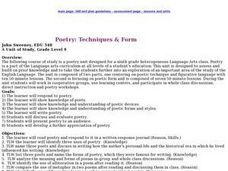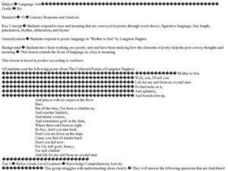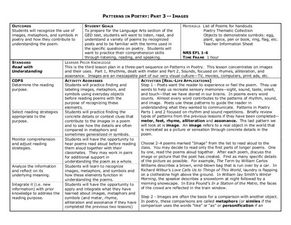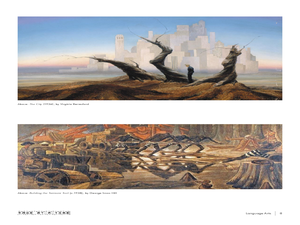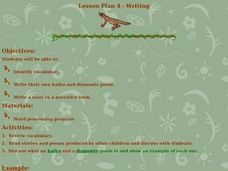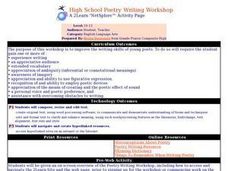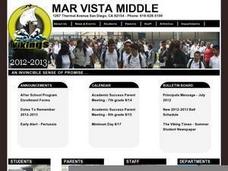Curated OER
Can You Figure Language?
Eighth graders study similes and metaphors and how to explain and create them. After a lecture/demo, 8th graders access websites and worksheets imbedded in this plan to create their own writing.
Curated OER
Asking Questions
Students examine a painting that depicts a scene from the Underground Railroad. They discuss the painting and write journal entries and poems in response to the painting's themes and their impressions.
Curated OER
Winter Wonderland: Internet Literature Project
Students, using the Internet, communicate with peers around the world about winter-themed books. They study authors, write book reviews, re-write endings, interview book characters, create scene dioramas, paint murals, and write...
EngageNY
Developing Reading Fluency: Criteria for Reading Aloud
Third graders develop their reading superpowers in a lesson plan on fluency. After first listening to an audio recording or teacher read aloud, the class works together identifying criteria for fluent reading, focusing on phrasing, rate,...
EngageNY
Developing Reading Fluency: Beginning the End of Unit 2 Assessment
Third graders continue to develop their reading fluency in preparation for their assessment in the tenth lesson plan of this unit. Young readers are provided with a short passage on Helen Keller, which they use while working in pairs...
Curated OER
Poetry: Techniques & Form
Ninth graders explore poetic technique and figurative language in this ten instructional activity unit. Comparisons are made between a variety of forms of poetic expressions and the lives of several poets are studied.
Curated OER
"How to Eat a Poem"
Eighth graders write a poem showing what they know about metaphors, and non-literal language to express ideas, convey meaning, and create images after they read Eve Merriam's "How to Eat a Poem".
Curated OER
Poetry language in "Mother to Son"
Sixth graders respond to poetry. In this poetry lesson, 6th graders read the "Mother to Son" by Langston Hughes and they are split into 3 groups for below, at and above grade level. Each group has a different activity to show...
Curated OER
Poetry to the Core
Second graders examine several examples of poetry in the six lessons of this unit. The lessons focus on five poetic forms, couplets, quatrains, limericks, Haiku, and free verse.
Curated OER
Patterns In Poetry: Images (Part 3)
High schoolers explore imagery in poetry. In this poetry lesson, students examine how the use of metaphors and similes aid in reading comprehension. Multiple resources are provided.
Curated OER
Art Analysis and Creative Writing
Students write an acrostic poem and analyze a work of art. In this art lesson plan, students look at a picture and answer questions about it, write a poem, write about the setting in the painting they saw, and answer short questions...
Curated OER
Acrostic Poems
Second graders listen to the book, SHARK WATCH as it is read to the class and name some of the facts they have learned about sharks from hearing the story. They then write an acrostic poem on the topic of sharks. Some of the students...
Curated OER
Acrostic Poems: What's In a Name?
Students find words that begin with the letters in their own names, using a variety of sources including word banks and online dictionaries. They create an acrostic poem. Pupils revise poems as needed, for meaning and conventions. ...
Curated OER
Poetry, Two Pictures
For this language arts lesson, students read several poems. They illustrate each poem, and discuss patterns in the poetry such as meter and alliteration. Guiding questions and answers are included with each poem or set of poems.
Curated OER
Writing
Fourth graders review the writing process by using the English Language Arts Writer's Checklist. They examine a piece of writing for the key elements of composition. They help to make the writing pieces more interesting by correcting...
Curated OER
Poetry: What's on Your Plate?
Students analyze "The Road Not Taken" and discuss examples of "roads traveled" by their own age group. In this poetry lesson, students read and discuss the meaning of the poem. Students choose another poem and review it for...
Curated OER
Music is Poetry
Students complete poetry analysis activities using music. In this music as poetry lesson, students review poetic devices and bring in selected music with lyrics and work in groups to listen as well as analyze the music as poetry.
Curated OER
High School Poetry Writing Workshop
Young scholars are given an on-screen overview of the Poetry Writing Workshop, including how to access and navigate the 2Learn Site and the web page, prior to signing up for the workshop or commencing work on the site.
Curated OER
A Selection of Mexican Art
Seventh graders participate in a supplemental instructional activity designed for McDougal Littell's Text "The Language of Literature". They view Mexican artwork by Frida Kahlo and Diego Rivera and complete an art viewing guide....
National Endowment for the Humanities
The World of Haiku
Middle schoolers complete a study of Japanese culture through haiku. They read and interpret haiku poetry and write haiku of their own.
Curated OER
Sor Juana, la monja y la escritora: Las Redondillas y La Respuesta
Sor Juana, considered one of the first feminist writers and a great Latin American poet, is the topic and inspiration for this excellent lesson. Use the introduction, guiding questions, and learning objectives to lead your class into a...
Curated OER
Moore vs. Livingston:Who Really Wrote 'The Night Before Christmas'
Students research an author and gather information that seems to support that person as author of The Night Before Christmas. They work in groups to gather the most solid evidence and they write a persuasive essay presenting their argument.
Curated OER
Anticipatory Sets for The Odyssey
Start your unit on The Odyssey in a fun and accessible way! Three options help your young readers grasp the concept of brave Odysseus's tale, including making masks of Greek gods and goddesses, and responding to different...
Curated OER
Identifying Text Features of a Self-Written Fable
Make learning the parts of a book fun by having pupils construct their own glossary entries, table of contents, and title page. Beginning with a review of text features and a hunt for examples, kids use previously written fables to...





